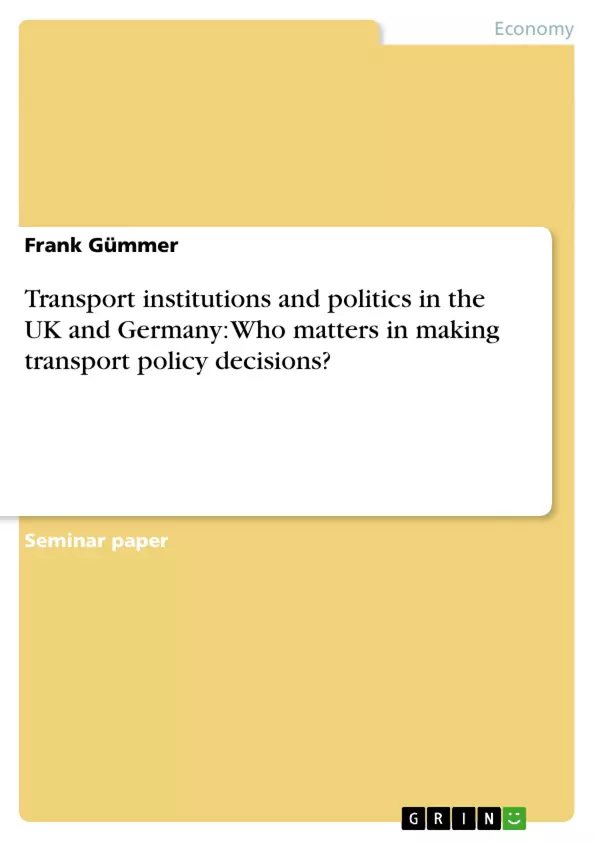The main aspect of this work is a report on who matters in making decisions on transport projects and policies. The roles of both individuals and groups involved in the decision making process on transport projects and transport policies will be examined. In this context, transport projects are for example new infrastructure projects, whereas transport policies refer to the regulation and pricing of transport.
First, the British system of decision making in transport is described, followed by a brief description of the German system and a comparison of both systems. Then the influence of pressure groups is examined and some examples of successful pressure group interference are presented. Two case studies examine the decision making process in practice and illustrate the variety of involved parties. Finally, some major conclusions are drawn, reflecting the author’s personal opinion.
Inhaltsverzeichnis (Table of Contents)
- Assignment...
- Decision-makers in transport politics in Britain
- Central Government
- Local government
- The influence of European Union policies
- Comparison of the British and the German transport policy system
- A short overview of the German system
- Federal level responsibilities
- Federal state level responsibilities
- Communal level responsibilities
- Major differences between the British and the German transport policy system
- A short overview of the German system
- The role of interest and pressure groups
- Principles of interest and pressure groups
- Examples of successful interventions
- Case study 1: the METRORAPID project in Germany
- Introduction
- The involved parties
- Summary
- Case study 2: the heavy goods vehicle toll on German motorways
- Introduction
- The decision in detail
- Summary
- Conclusions
- Summary
- The division between local and central responsibilities
- Do we need pressure groups?
- The growing importance of courts in decision-making
Zielsetzung und Themenschwerpunkte (Objectives and Key Themes)
This report investigates the decision-making process for transport projects and policies, analyzing the roles of both individuals and groups involved. It examines the British and German systems, highlighting their differences, and explores the influence of pressure groups. Two case studies illustrate the practical application of these decision-making processes.
- The role of government in transport policy and the influence of European Union policies
- The impact of pressure groups on transport decision-making
- The comparison of transport policy decision-making systems in Britain and Germany
- The analysis of case studies showcasing the practical application of these decision-making processes
- The importance of courts in influencing transport policy decisions
Zusammenfassung der Kapitel (Chapter Summaries)
- Assignment: This chapter introduces the objective of the report, which is to analyze the roles of individuals and groups in making transport policy decisions. It outlines the structure of the report.
- Decision-makers in transport politics in Britain: This chapter examines the role of central government, local government, and the influence of European Union policies in shaping transport decisions in Britain. It highlights the key decision-makers and their limitations.
- Comparison of the British and the German transport policy system: This chapter provides a concise overview of the German system for transport policy decision-making, including responsibilities at the federal, state, and local levels. It highlights the key differences between the British and German systems.
- The role of interest and pressure groups: This chapter explores the principles of interest and pressure groups and their impact on transport policy decisions. It presents examples of successful interventions by pressure groups.
- Case study 1: the METRORAPID project in Germany: This chapter examines the METRORAPID project in Germany, analyzing the involved parties and the decision-making process.
- Case study 2: the heavy goods vehicle toll on German motorways: This chapter explores the decision-making process for implementing a heavy goods vehicle toll on German motorways.
Schlüsselwörter (Keywords)
This report focuses on transport institutions and politics, analyzing decision-making processes for transport projects and policies. Key topics include the roles of central and local government, the influence of the European Union, the impact of pressure groups, and the comparison of the British and German transport policy systems. The report also examines practical case studies, highlighting the involvement of various actors in the decision-making process.
- Arbeit zitieren
- Frank Gümmer (Autor:in), 2002, Transport institutions and politics in the UK and Germany: Who matters in making transport policy decisions?, München, GRIN Verlag, https://www.grin.com/document/18822



